Westhoughton
Westhoughton (/wɛstˈhɔːtən/ west-HAW-tən) is a town and civil parish in the Metropolitan Borough of Bolton, Greater Manchester, England.[1] It is 4 miles (6 km) southwest of Bolton, 5 miles (8 km) east of Wigan and 13 miles (21 km) northwest of Manchester.[2]
| Westhoughton | |
|---|---|
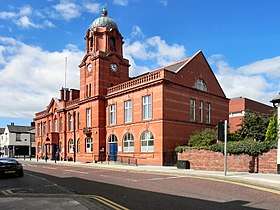 Westhoughton Town Hall, built 1903 | |
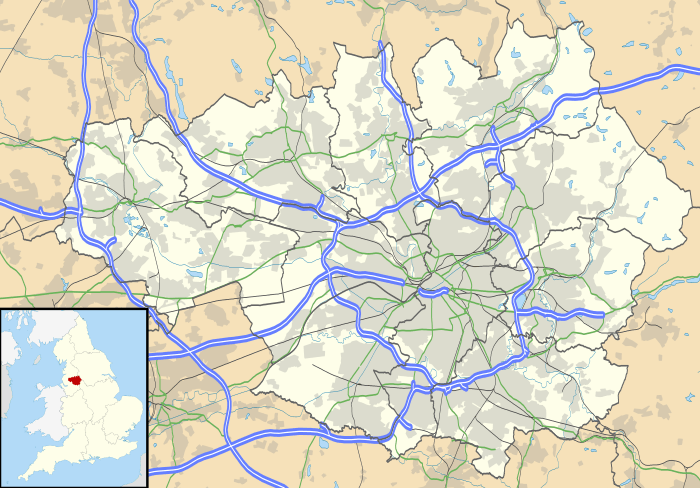 Westhoughton Location within Greater Manchester | |
| Population | 24,974 (2011 Census) |
| OS grid reference | SD6505 |
| Civil parish |
|
| Metropolitan borough | |
| Metropolitan county | |
| Region | |
| Country | England |
| Sovereign state | United Kingdom |
| Post town | Bolton |
| Postcode district | BL5 |
| Dialling code | 01942 |
| Police | Greater Manchester |
| Fire | Greater Manchester |
| Ambulance | North West |
| UK Parliament | |
| Website | Westhoughton Online |
Historically in Lancashire, Westhoughton was once a centre for coal mining, cotton-spinning and textile manufacture. It had a population of 24,974 at the 2011 Census.[3][4]
Westhoughton incorporates several former villages and hamlets which have their own distinctive character, sports traditions and amenities, including Wingates, White Horse, Over Hulton, Four Gates, Chequerbent, Hunger Hill, Snydale, Hart Common, Marsh Brook, Daisy Hill and Dobb Brow.[5]
History
Toponymy

The name Westhoughton is derived from the Old English, halh (dialectal "haugh") for a nook or corner of land, and 'tun for a farmstead or settlement – meaning a "westerly settlement in a corner of land". It has been recorded variously as Halcton in 1210, Westhalcton in 1240,Westhalghton in 1292, Westhalton in 1302 and in the 16th century as Westhaughton and Westhoughton.[6][7]
The people of Westhoughton are sometimes known as "Howfeners" (from Houghton) or "Keawy-eds" (cow heads) or "Keawyedners" (a combination of the two), and the town is known as "Keawyed City". Supposed folklore ("re-invented" in the Edwardian period) describes a farmer who found his cow with its head stuck in a five barred gate, and, rather than damage the gate, cut the cow's head off, as the cow cost less than the gate.[8] The village of Tideswell in Derbyshire shares this same legend.[9]
Banastre Rebellion
In 1315 a group of men led by Sir William Bradshaigh of Haigh Hall, Sir Henry Lea of Charnock Richard and Sir Adam Banastre met at Wingates to plan a campaign of violence against Sir Robert de Holland of Upholland, chief retainer of the powerful Earl of Lancaster. The campaign came to be known as the Banastre Rebellion and ended with the deaths of most the main protagonists.[10]
Civil War
On 15 December 1642, during the English Civil War, the Battle of Warcock Hill was fought on Westhoughton Common between Lord Derby's Cavalier forces and Parliamentarians. The site of the battle was off the Manchester Road where Wayfaring is today. The Parliamentarians under Captains Bradshaw, Venables and Browne ran into a force of some thousand Royalists from the Wigan garrison under Lord Derby and were forced to surrender. The three captains and 160 men were taken prisoner.
It is believed that Prince Rupert of the Rhine gathered his troops in Westhoughton before the attack and ensuing massacre at Bolton in 1644.[6] Civil War activity is also known to have occurred around the site of Hunger Hill and a sword claimed to be from the time of the Civil War was discovered in the garden of one of the cottages at Pocket Nook in Chew Moor during the 1950s.
Industrial Revolution
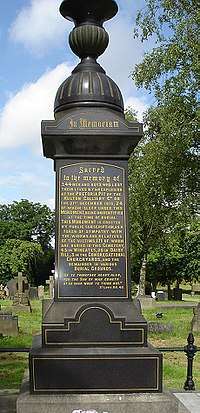
On 25 March 1812 a group of Luddites burned Rowe and Dunscough's Westhoughton Mill, in one of the first terrorist acts in Britain. Twelve people were arrested on the orders of William Hulton, the High Sheriff of Lancashire.[11][12] James Smith, Thomas Kerfoot, John (or Job) Fletcher and Abraham Charlston, were sentenced to death for their part in the attack. The Charlston family claimed that Abraham was only twelve years old; but he was not reprieved.[11] The men were publicly hanged outside Lancaster Castle on 13 June 1812.[13] It was reported that Abraham cried for his mother on the scaffold.[12] By this time, however, hanging of those under 18 was rare and of those under 16, in practice, abolished.[14] Nine others were transported to Australia.[15] The riots are commemorated by a blue plaque on the White Lion public house opposite the mill site.
In 1891 the Rose Hill Doubling Mill had 8,020 spindles and Higson and Biggs' Victoria Mill had 40,000 spindles. Bolton Road Mill housed 564 looms weaving shirtings and Perseverance Mill had 600 looms manufacturing twills, sateens and plain cotton cloth. The looms in John Chadwick's Silk Mills produced broad silks, tie silks, scarves and handkerchiefs. The Lancashire Hosiery Company produced vests. Thomas Welch was a calico printer at the Green Vale Print Works.[16]
The family of William Hulton of Hulton Park owned many small collieries from the 16th century. After 1828 the pits at Chequerbent were served by the Bolton and Leigh Railway. The Hulton Colliery Company sank Chequerbent Colliery in 1892 and Bank Pit Nos 1–4 between 1897 and 1901. The company mined the Trencherbone, Plodder and Arley seams. Bank Pit No 3, known as the Pretoria Pit, was the site of one Britain's worst coal-mining disasters when on 21 December 1910, 344 men and boys died in an explosion of firedamp.[17] The Pretoria Pit Disaster was the third worst in British mining history, after the 1866 Barnsley Oaks Disaster in Yorkshire,[18] and the 1913 Senghenydd Colliery Disaster in Glamorgan.[19] A memorial erected in 1910 is grade II listed.[20]
In 1896 the Wigan Coal and Iron Company's Eatock Pits employed 484 underground and 89 surface workers whilst the Hewlett Pits, at Hart Common, employed 981 underground and 182 on the surface.[21]
Governance
Lying within the boundaries of Lancashire since the early 12th century, Westhoughton was a chapelry and township in the ecclesiastical parish of Deane, in the Salford hundred. In 1837, Westhoughton joined with other townships (or civil parishes) to form the Bolton Poor Law Union and took joint responsibility for the administration and funding of the Poor Law in that area.[22] In 1872, a Local board of health was established for the township, but was superseded in 1894 by the creation of Westhoughton Urban District which shared local government responsibilities with Lancashire County Council. In 1898 most of Over Hulton became part of the urban district.[23] Westhoughton Town Hall was built in 1903 to a plan by Bradshaw and Gass, architects of Bolton replacing the Local Board Offices at the junction of Market Street and Wigan Road.[24]
Under the Local Government Act 1972, Westhoughton Urban District was abolished in 1974 and its area became a civil parish of the newly created Metropolitan Borough of Bolton in Greater Manchester.[25] It is represented by six councillors elected in two borough wards – Westhoughton North and Chew Moor and Westhoughton South – on the metropolitan borough council.[26]
Westhoughton civil parish, gained town council status in 1985, and has 18 town councillors elected from six town council wards – Central, Chequerbent, Daisy Hill, Hoskers and Hart Common, White Horse, and Wingates.[27] Each year the town council elects a town mayor.
Parliamentary representation
For 98 years, between 1885 and 1983 the Westhoughton constituency represented the town. Although, since 1906, always returning a Labour candidate, the elections were, after 1950, a close run contest, due to the working class conservatism found in Westhoughton and surrounding areas and the inclusion of more rural (Conservative) areas in boundary revision. At the 1906 general election, the birth of the modern Labour Party, William Tyson Wilson was one of 29 successful "Labour Representation Committee candidates."
The constituency had by-elections in 1921, 1951 and 1973 due to the retirement, ill-health or death of the sitting MPs. The last MP for Westhoughton was Roger Stott (Labour) who, on abolition of the Westhoughton constituency, was elected MP for Wigan in 1983, his relatively swift death there prompting a by-election.
The 1983 redistribution of seats reflected local government reforms made in 1974. In September 2011, the Boundary Commission for England proposed recreating a Westhoughton constituency to incorporate Westhoughton, Blackrod, Hindley, Atherton, and parts of Horwich and Leigh[28][29]
Geography
Westhoughton covers an area of 4,341 acres (1,757 ha) and has an average breadth of over 2 miles (3.2 km) from north-east to south-west, and an extreme length of nearly 3.5 miles (5.6 km) from northwest to south-east. The highest ground at over 480 feet (150 m) is to the north east with the land sloping downwards to the south-west. The lowest point at about 120 feet (37 m) is in the extreme southerly corner. Borsdane Brook separates the township from Aspull, another brook divides it from Hindley joining a stream which rises on the northern edge of Westhoughton and flows south through Leigh to Glazebrook.[6] The town incorporates several former villages and hamlets including railway stations including Wingates, White Horse, Over Hulton, Four Gates (or Fourgates), Chequerbent, Hunger Hill, Snydale, Hart Common, Marsh Brook, Daisy Hill and Dobb Brow.[5]
Local Nature Reserves are located at Hall Lee Bank Park, Cunningham Clough, and Eatock Lodge at Daisy Hill.[30]
Demography
|
|
| |||||||||||||||||||||||||||||||||||||||||||||||||||||||||||||||||||||
| Sources:[31][32][33][34][35][4][3] | |||||||||||||||||||||||||||||||||||||||||||||||||||||||||||||||||||||||
Education
The long established St John's, Wingates CE Primary & Fourgates County Primary schools were closed in 2004 following amalgamation to form The Gates CP School. Westhoughton CP School closed in 2008. An earlier round of reorganisation saw the closure of Hart Common Primary School and opening of St George's on The Hoskers, and the closure of the tiny County Primary at White Horse which is now a private nursery.
| School | Type/Status | Ofsted | Website |
|---|---|---|---|
| Eatock Primary School, Daisy Hill | Primary | 105202 | Official site |
| Sacred Heart R.C. Primary School | Primary | 105243 | Official site |
| St George's C.E. Primary School | Primary | 131038 | Official site |
| St James C.E. Primary School, Daisy Hill | Primary | 105209 | Official site |
| St Thomas' C.E. School, Chequerbent | Primary | 105234 | Official site |
| The Gates Primary School | Primary | 133926 | Official site |
| Washacre Primary School | Primary | 105199 | Official site |
| St. Bartholomew's C of E Primary School originally Westhoughton Parochial C.E. Primary School |
Primary | 105237 | Official site |
| Westhoughton Primary School (closed 2008) | Primary | 105180 | Official site |
| Westhoughton High School | Secondary | 105252 | Official site |
Religion
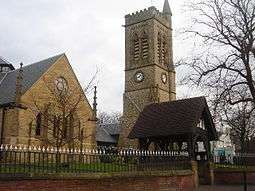
Westhoughton's old chapel of 1552 was replaced by a brick-built church in 1731 and a third church, the parish church, was built in 1869–70.[6] The church, dedicated to Saint Bartholomew, had an east window depicting the twelve apostles. On 28 November 1990 the church was gutted by fire, but the tower was saved[36] and is Grade II listed[37] as was a sundial in the churchyard which was stolen in 1992.[38] A fourth church, designed by architect John Ashworth of Dane, Ashworth & Cottam, was built by Laing North West with Bradshaw Gass & Hope as project managers and structural engineers at a cost about £1 million.[39] After the fire, services were held the parochial school and the church bought the town's redundant telephone exchange as church hall. The fourth church was consecrated on 28 October 1995 by the Right Reverend Christopher Mayfield, Bishop of Manchester.[40] Nicholsons of Malvern built its two manual organ with 1,256 pipes, ranging from 1/2 inch to 16 feet (4.9 m) made of tin, spotted metal and hammered lead.[41]
Other Anglican churches include St John the Evangelist in Wingates, and Austin and Paley's St James' Church, Daisy Hill, a Grade II* listed building.[42] The parish church had two daughter churches, St Thomas' Church at Chequerbent, and Hart Common Church. St Thomas' Church was demolished when the M61 motorway was built and the new St Thomas' School incorporated a church. Hart Common Church joined with the Methodist and URC Churches to establish an LEP and the old Hart Common Church was sold to the Hindley Christian Fellowship. St George's Church opened in 1996.
The Roman Catholic community is served by Sacred Heart Parish Church. When the old church building fell into disrepair, it was demolished and replaced by a new building incorporating a church hall.
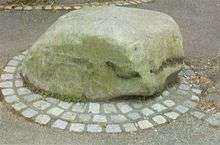
John Wesley preached a sermon at Barnaby's Farm in Wingates in April 1784. Services were held in cottages opposite the farm which became known as 'Methody Row' before the first Methodist church was built in 1835. Another Methodist Church was built in Dixon Street in 1871. Houses occupy the site of Westhoughton Independent Methodist Church, where Wesley once stood, but the stone, from which he preached, was moved to Grove Lane Chapel, now Westhoughton Methodist Church's church hall. The final service was held by the Independent Methodist Church on 6 May 2001 and the church was subsequently demolished.[43] Daisy Hill Methodist Church was closed and demolished in the late 1980s. The new, Methodist church was built adjacent to Grove Lane Chapel, which now serves as church hall.[44]
The industrial north west was a focus for non-conformism, and until the 1990s the Church of the Nazarene stood in Church Street. The Quaker Meeting House is now a Christian fellowship,[45] and a tin tabernacle was situated off Bolton Road. There is a Pentecostal church, a United Reformed Church, 'The Bethel' and an independent church on Tithbarn Street.[46]
Landmarks
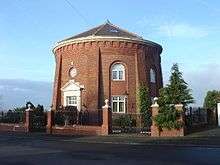
Snydle water tower was built by Westhoughton Council in 1914 and lay derelict for many years with its tank removed and the tower open to the sky. It has been restored and converted into a private dwelling that is visible from the M61 motorway.
The Church of England School built in 1861, opposite St Bartholomew's church, is a Grade II listed building[47] as are houses at 110 and 112, Market Street.[48] The school, which was known as Westhoughton Parochial School, has been renamed St Bartholomew's Church of England, Primary School.
The red brick and terracotta town hall and Carnegie library were built between 1902 and 1904 to the designs of Bradshaw & Gass.
Transport
The M61 motorway passes through the north of the town which it serves by junctions 5 and 6. The A58 and the A6 cross the town as do the B5236, the B5235, and the B5239. The motorway separated the townships of Hunger Hill and Chew Moor from the rest of Westhoughton and the Bolton Road was completely severed. A new link road, Snydle Way, was built between Chequerbent and a spur to the old Bolton Road, via a roundabout at M61 junction 5. Snydle Way, a broad, dual carriageway, was built to full 4 lane motorway standard, with a broad centre verge allowing widening to 6 lanes. The original intention was that it would form the beginning of a new motorway, running southwest, linking the M61 with the M6. Although the route was fully allocated and all planning and public consultation completed, the project was shelved due to financial constraints.
Westhoughton railway station and Daisy Hill railway station are served by Northern trains between Southport and Manchester via Wigan Wallgate. Trains from Westhoughton to Manchester Piccadilly run via Bolton; trains from Daisy Hill to Manchester Victoria run via Atherton. Formerly there were stations at Chequerbent (closed 1952)[49] Dicconson Lane and Hilton House both closed in 1954.[50]
In the late 1980s, a railway station planned for Dobb Brow was not built.[51] Lostock and Horwich Parkway stations, to the north, also serve the town. The annual usage of Daisy Hill and Westhoughton stations was more than 500,000 passengers in 2013/14, greater than many major UK towns.[52]
Electric trams to Bolton served Westhoughton until 1947 after 23 years of service. On 19 December 1924, the Bolton to Deane service was extended to Westhoughton).
Westhoughton is served by bus services to Bolton, Wigan and Leigh. The most frequent service between Bolton and Wigan is operated by Stagecoach Manchester. Other services between Leigh and Horwich are operated by Diamond Bus North West and Stagecoach. The Blackrod – Little Lever service is operated by Diamond Bus North West and Bolton to Westhoughton by Arriva North West, continuing to Wigan by Diamond Bus North West.
Media
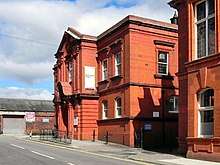
The weekly Horwich and Westhoughton Journal was published (by The Bolton News) from 1925 until 1980, and had an editorial and revenue office in Market Street.[53]
The town's Carnegie library is at the rear of the Town Hall.[54] Its Carnegie Hall is used for meetings and other activities.[55] A small museum has exhibits that relate to the Pretoria Pit Disaster and a large, encased model, of the original St. Bartholomew's Parish Church, built from match-sticks.
Notable residents
- Robert Shaw (1927–1978)– actor, born at 51 King Street on 9 August 1927.[56] Shaw appeared in From Russia With Love and A Man for All Seasons and later in The Sting and Jaws.[57]
- Rev. Peter Ditchfield – historian and author
- Bill Farrimond – cricketer, played for England.[58]
- Ethel Johnson – sprinter, represented England at the 1932 Los Angeles Summer Olympics[59]
- Jack Bruton (1903–1986) – footballer for Bolton Wanderers, Burnley and England.[60]
- Francis Lee – footballer for Bolton Wanderers, Manchester City, Derby County and England (27 caps).
- Dick Pollard – cricketer, played for England.[61]
- Maxine Peake - actress, was born in Westhoughton on 14 July 1974.
- Houghton Weavers – a folk group who had a BBC Television series, Sit thi' Deawn, in the 1970s, and a radio show.
- Wingates Band - one of the best-known brass bands in the United Kingdom. Formed in 1873.
See also
- Listed buildings in Westhoughton
- Chequerbent railway station
- Chequerbent railway station (1831)
- Borsdane Wood
- Daisy Hill F.C.
- Westhoughton Greyhound Track
- List of mining disasters in Lancashire
References
- "Greater Manchester Gazetteer". Greater Manchester County Record Office. Place Names T to W. Archived from the original on 18 July 2011. Retrieved 26 September 2007.
- AA Route Planner. URL accessed 29 May 2007.
- "Area: Westhoughton (Parish), Key Figures for 2011 Census: Key Statistics". Office for National Statistics. Retrieved 4 January 2016.
- "Area: Westhoughton (Parish), Key Figures for 2001 Census: Key Statistics". Office for National Statistics. Retrieved 22 May 2007.
- Westhoughton Township Boundaries, GenUKI, retrieved 6 January 2012
- Farrer, William; Brownbill, J, eds. (1911), "Westhoughton", A History of the County of Lancaster: Volume 5, Victoria County History, British History Online, pp. 20–25, retrieved 31 August 2010
- Billington, W.D. (1982). From Affetside to Yarrow : Bolton place names and their history, Ross Anderson Publications (ISBN 0-86360-003-4)
- Bolton Museum & Archive Service. "Westhoughton Keaw Yed (cow head) re-enactment circa 1919". flickr.com. Retrieved 11 May 2013.
- "A Derbyshire Poem: The Drunken Butcher of Tideswell". Peak District Online. Retrieved 10 September 2011.
- "Mabs Cross Legend and Reality". Retrieved 24 September 2011.
- Spatacus schoolnet – The Luddites URL accessed 22 May 2007.
- Cotton Times – Luddites: War against the machines – Page 2 Archived 25 July 2008 at the Wayback Machine. URL accessed 22 May 2007.
- Capital Punishment U.K. – Public executions 1800–1827. URL accessed 22 May 2007.
- The execution of children and juveniles. URL accessed 22 May 2007.
- Westhoughton Calendar of Events. Lancashire OnLine Parish Clerks. URL accessed 22 May 2007.
- Westhoughton. 5 miles W.S.W. from Bolton (p73), Grace's Guide, retrieved 22 November 2013
- The Pretoria Pit Disaster. Lancashire OnLine Parish Clerks. URL accessed 22 May 2007.
- The Barnsley Oaks Colliery. URL accessed 22 May 2007.
- The Senghenydd Coal Mining Disaster. URL accessed 22 May 2007.
- Historic England, "Memorial to those killed in the Pretoria Pit Disaster approx. 127m north west of St. Bartholomew's Church (1162905)", National Heritage List for England, retrieved 10 November 2013
- Wigan Coal & Iron Co. Ltd., Durham Mining Museum, retrieved 7 February 2011
- Workhouse, workhouses.org.uk, retrieved 28 November 2010
- Westhoughton UD: Historical Boundaries. Vision of Britain. URL accessed 26 February 2008.
- "Places of interest" at bolton.gov.uk
- "Greater Manchester Gazetteer". Greater Manchester County Record Office. Place Names T to W. Archived from the original on 18 July 2011. Retrieved 22 May 2007.
- Bolton Metropolitan Borough Councillors Archived 10 February 2007 at the Wayback Machine. URL accessed 22 May 2007.
- Town Council Election Results 2007 – Blackrod, Horwich, and Westhoughton. URL accessed 22 May 2007.
- Westhoughton map Boundary Commission for England
- Initial Proposals – Greater Manchester Boundary Commission for England
- "Local Nature Reserves". Retrieved 17 August 2011.
- Tatton, Pauline. Local population statistics 1801–1986: abbreviated tables compiled from census statistics for Bolton. Bolton Libraries.
- Great Britain Historical GIS Project. "Westhoughton Ch/CP/Tn: Total Population 1881–1961". A Vision of Britain through Time. University of Portsmouth. Retrieved 13 September 2017.
- Great Britain Historical GIS Project. "Westhoughton USD: Population 1891". A Vision of Britain through Time. University of Portsmouth. Retrieved 22 May 2007.
- Great Britain Historical GIS Project. "Westhoughton UD: Population 1901–1961". A Vision of Britain through Time. University of Portsmouth. Retrieved 26 February 2008.
- The 1939 population is estimated from the number of identity cards issued to the inhabitants of Westhoughton in that year, which were required under the National Registration Act 1939. The 1941 census did not take place because of the Second World War.
- St Bartholomew's Church, Westhoughton (Lancashire OnLine Parish Clerk Project). URL accessed 26 October 2006.
- Historic England, "Tower of Church of St Bartholomew, School Street (1356786)", National Heritage List for England, retrieved 10 November 2013
- Historic England, "Sundial approx 17 m to south of Church of St Bartholomew (1067274)", National Heritage List for England, retrieved 10 November 2013
- Bradshaw Gass & Hope website. URL accessed 26 October 2007.
- "Blessing for church that's risen from ashes". The Bolton News. Newsquest Media Group. 30 October 1995.
- Completed Projects Archive: St Bartholomew's Church, Westhoughton. Nicholsons of Malvern. URL accessed 26 October 2006.
- Historic England, "Church of St James (1067273)", National Heritage List for England, retrieved 10 November 2013
- "Places of interest – John Wesley in Wingates" at bolton.gov.uk
- "Westhoughton Methodist Church, Bolton Methodist Circuit" at homepages.tesco.net
- Westhoughton, GenUKI, retrieved 6 February 2012
- "Westhoughton Pentecostal Church" at ukchurch.org
- Historic England, "Westhoughton Church of England Primary School (1162908)", National Heritage List for England, retrieved 10 November 2013
- Historic England, "110 and 112 Market Street (1162880)", National Heritage List for England, retrieved 10 November 2013
- Subterranea Britannica: SB-Sites: Chequerbent Station (2nd site).
- Daniels, Gerald; Dench, Les (10 November 1980). Passengers No More (Third ed.). Littlehampton Book Services Ltd. ISBN 0711009511.
- "BEN OPINION: Top priority on the trains". The Bolton News. Newsquest Media Group. 28 October 2000.
- Network Rail
- Bolton Library and Museum Services. "Bolton Newspapers". boltonlams.co.uk. Retrieved 28 August 2011.
- Bolton Council. "Westhoughton Library". bolton.gov.uk. Retrieved 17 June 2018.
- Westhoughton Local History Group. "Meeting Place: Westhoughton Library". westhoughtonhistorygroup.org.uk. Retrieved 17 June 2018.
- "Mayor to unveil plaque in honour of Jaws star". The Bolton News. Newsquest. 19 July 1996. Retrieved 18 June 2018.
- "Town council claims Jaws star 'not a true Howfener'". The Bolton News. Newsquest. 13 August 2009. Retrieved 18 June 2018.
- "TheCricketer". Archived from the original on 24 March 2012. Retrieved 17 August 2011.
- "History of Westhoughton". Retrieved 26 October 2013.
- "John Bruton". englandstats.com. Retrieved 14 November 2013.
- "Obituaries". Wisden Cricketers' Almanack (1986 ed.). Wisden. p. 1218.
External links
| Wikimedia Commons has media related to Westhoughton. |